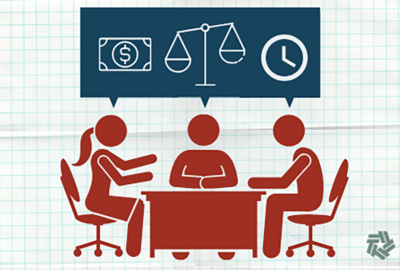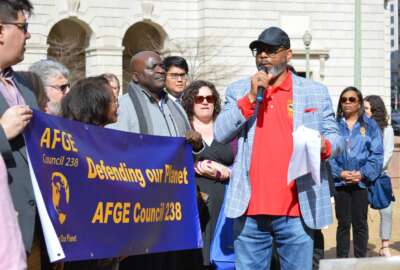Hubbard Radio Washington DC, LLC. All rights reserved. This website is not intended for users located within the European Economic Area.
A quarter of federal employees feel burnout, causing high turnover and low morale, study finds
A recent Gallup study of more than 5,400 survey respondents finds 26% of federal employees say they “very often” or “always” feel burned out at work.
More than a quarter of the federal workforce is feeling burnout, according to a recent study, making them more likely to leave their agency or feel less engaged in their work.
A recent Gallup study of more than 5,400 survey respondents finds 26% of federal employees say they “very often” or “always” feel burned out at work.
Rob DeSimone, associate principal of workplace initiatives at Gallup, says that level of burnout can lead to high attrition rates.
“When people are burned out, they’re much, much more likely to leave their agency,” DeSimone said.
The study also finds a high attrition rate can also lead to higher labor costs. Gallup estimates that in an agency of 10,000 employees, with an average salary of $50,000, low engagement contributes to $66 million in annual costs.
Gallup bases those figures on research from the Society for Human Resources Management, which shows it costs six-to-nine months of most employees’ salary to replace them — and that the cost is even higher for more senior-level vacancies.
Mike Ritz, executive director of Gallup’s Federal Government Initiative, said these costs also stem from burned-out employees feeling less productive and less engaged with their work.
“When you become actively disengaged, when you’re a person that literally feels miserable at their job, and you are disconnecting from your job, let’s face it, you might even take down the ship, if you had the opportunity — because you have that much contempt for the employer that they’re not meeting your needs,” Ritz said.
No ‘silver bullet’ solutions
The study takes a closer look at some of the federal employee stressors that agencies have anecdotally observed, but not fully quantified.
The Department of Veterans Affairs, for example, is addressing burnout among its health care workforce through its REBOOT task force. The VA, more recently, is looking at artificial intelligence tools to reduce administrative burdens on clinicians — a driver of burnout.
The Partnership for Public Service is also tracking a steady decline in work-life balance scores from federal employees, as measured by its Best Places to Work in the Federal Government rankings.
Ritz said there are no “silver bullet” solutions to address burnout across the entire federal workforce. But Gallup identified five root causes of these challenges — unfair treatment at work, unmanageable workloads, unclear communication from managers, lack of manager support and unreasonable time pressure.
“It seems like the more we learn, the more we realize that it’s very individual for each person, and what works for one might not work for another. So, this idea of, ‘Let’s just give everybody time off, that’ll work’ — well, that might work for some, but not for others,” he said.
The study also finds that employees sometimes cope with burnout in ways that only exacerbate the problem.
“[If] you’re a person that really is a high achiever — you like to [be] task-driven, and really achieve your tasks and get things done — a natural coping mechanism, when you’re feeling burned out is, ‘Let me just do more. Let me get to it faster’ … If those executing folks would stop and take their time to think through their situation, stop and pause, think through the situation there, they will reduce their burnout by 48%,” Ritz said.
Role of managers contributing to burnout
Management behavior plays a major role in a federal employee’s workplace experience. Gallup finds managers account for about 70% of their team’s engagement scores. The study also finds managers experience burnout at a higher rate (35%) than the federal employees they oversee (23%).
“If managers are burned out, that’s flowing down to all the employees within the agency,” Ritz said. “It’s the manager that can be the one that can help prevent and reverse burnout among the team, while also increasing productivity — and that requires a very individualized approach to understand how can we manage workloads. How can we manage prioritization, alongside what the wellbeing of the team is, alongside what some of the pressures are coming from whatever the performance initiatives are? It’s really the manager that has that ability to juggle those three things.”
Jay Hoffman, chief financial officer for the U.S. Patent and Trademark Office, agreed that managers play a major role in combatting burnout within agencies.
“When managers are engaged, their employees are more likely to be engaged as well,” Hoffman said.
Effective managers also help employees manage workloads and communicate clear expectations. Gallup found that about 42% of federal employees said they know what’s expected of them at work.
“What that’s really saying is that managers themselves, oftentimes, might lack clarity — not so much about what it is they have to do — they’re usually very clear about that,” DeSimone said. “They might not know, ‘What are the relationships that I need in this organization? Who do I need to be collaborating with in order to achieve our bigger goal?’ And for some organizations, they may not even know what their bigger goal is, or where exactly they fit in.”
Gallup’s research into employee burnout also finds that the way people experience their workloads has a stronger influence on burnout than the number of hours worked.
“In the federal government, there are a lot of empty seats right now. A lot of folks have gone elsewhere, for a variety of different reasons. And of course, talent is at a premium across all sectors and industries,” Ritz said. “So, if you’re already feeling like your workload is tough, and then the guy next to you is no longer there, and the guy to your right is gone … did my workload just get even tougher? Who’s helping me manage that? Who’s the person that is having that strong influence of how I experienced that workload?”
A ‘game-changer’ for burnout? Meaningful conversations
Ritz said managers who have one “meaningful conversation” with an employee who reports to them at least once a week are a “game-changer” for burnout. That conversation can take as little as 15-30 minutes.
“It needs to be a conversation that talks about their goals, their personal development, things that have meaning to that person that is reporting up to that manager. And that can make a massive impact,” Ritz said.
James Egbert, branch chief for human capital strategy at the Department of Health and Human Services, meaningful one-on-one conversations with employees can make a huge difference in employee engagement.
“I’ve learned that if you want to improve employee engagement, you must engage with your people. Listen, ask and listen some more,” Egbert said.
Ritz said employees who strongly agree that their employer cares about their overall wellbeing are three times more engaged, and 71% less likely to report feeling burnout.
DeSimone the most important thing managers can do to address burnout is to provide “meaningful feedback.” That feedback, he added, is valuable for managers to give their supervisors, as well as the employees they oversee.
“Employees don’t want to wait three months or wait 12 months to figure out in their performance review what their mistakes are. They want to know, that minute, if not that day. They want to know, what did I do right? And also, what are my areas for improvement? They want to hear both,” DeSimone said.
The study finds that engaged federal employees are not just more productive — they’re also more likely to stay at their agencies.
“If you have somebody that is fully engaged, then you need 20% more in terms of higher pay, in order for that person to want to leave their current job. But if you have somebody who’s not engaged, then they’ll leave for a 0% increase,” DeSimone said. “They’re just looking for a better environment, and you can send it their way. They’re looking to be alleviated from that burnout situation they find themselves in.”
Copyright © 2024 Federal News Network. All rights reserved. This website is not intended for users located within the European Economic Area.
Jory Heckman
Jory Heckman is a reporter at Federal News Network covering U.S. Postal Service, IRS, big data and technology issues.
Follow @jheckmanWFED
Related Stories
Related Stories
-
VA launches AI Tech Sprint to reduce burnout among health care employees Artificial Intelligence





